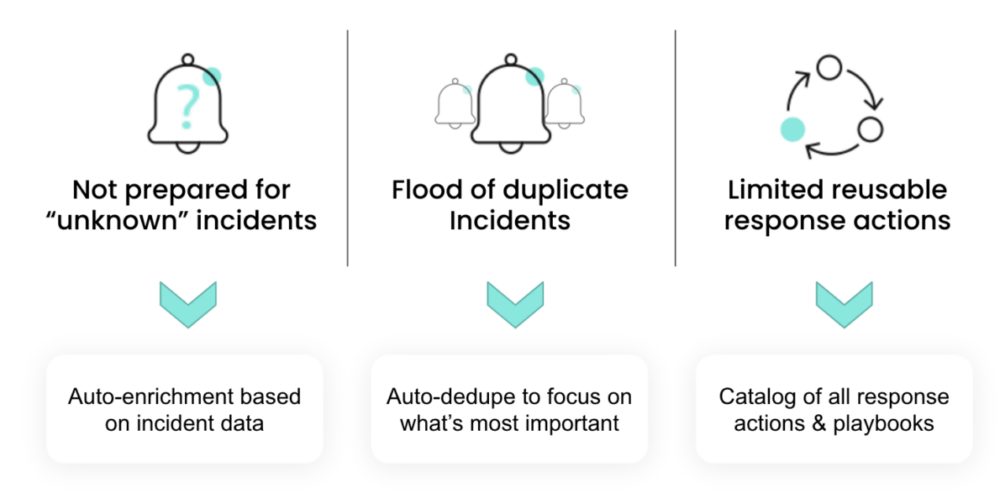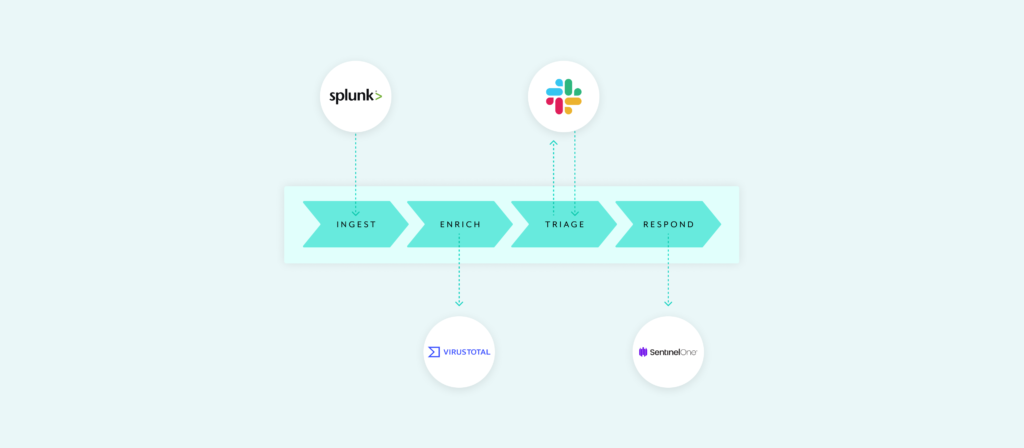Security teams face an overwhelming number of alerts.
According to a study by Orca Security, 59% of organizations collect more than 500 cloud security alerts per day—leading to a host of issues. For example, the same study found that more than half of critical alerts (55%) fail to be addressed on a routine basis (as often as every day), while 60% of respondents cite “alert fatigue” as a cause of internal friction.
So, how can your organization manage such a high volume of alerts successfully and without overburdening your security team? By using an enterprise automation platform as your SOAR solution.
We’ll break down how enterprise automation can be used in the context of SOAR by sharing an example. But to start, let’s align on the acronym’s definition.
What is SOAR?
SOAR, or security orchestration, automation, and response, is a type of solution that can collect security data from various sources (e.g. your SEIM tool) and, depending on the incident it uncovers, trigger a workflow automation that’s geared towards address it.
The nuance here lies in the type of tool that’s used. For example, many offer fairly basic workflow automation capabilities that only allow you to streamline the tedious parts of your incident management process. As you’ll soon learn, enterprise automation bucks this trend, as it empowers your security team to build comprehensive and intelligent automations, quickly.
Related: A guide to automating incident management
An example of using enterprise automation as your SOAR solution
A SOAR solution typically aims to tackle any of the following stages:
- Ingestion: An incident is detected by a 3rd-party system and ingested into the SOAR pipeline
- Enrichment: Additional insights, like when and where an incident took place, get added
- Triage: Security analysts classify incidents, decide which to prioritize, and pinpoint the proper course of action for each
- Response: The response goes into action to remediate the issue and/or to prevent it from happening again
Each of the steps above can be automated with a SOAR tool, but by using an enterprise automation platform, the entire process can be automated seamlessly.
To help illustrate this idea, let’s cover an example where an alert gets created for an employee who’s visiting a website on their work-issued device that’s potentially malicious:

1. An application like Splunk detects an employee who’s browsing a domain that hasn’t been visited by any employee previously. The application goes on to create an alert for that activity.
2. An application like Virustotal checks the target domain’s reputation to determine whether it’s a malicious website.
3. Assuming the domain is deemed malicious, a security analyst gets notified of the alert via a message in an app like Slack.
4. Within the body of the message, the security analyst can review key details on the alert and take action with the click of a button; in this case, they’d disconnect the machine with a tool like SentinelOne.
Benefits of using enterprise automation for SOAR
Here’s why you should use enterprise automation as your SOAR platform:
Address incidents faster
By automatically creating alerts, routing them to the appropriate employees in near real-time, and allowing these employees to take action with ease, your organization is more likely to resolve issues before they can cause meaningful damage. In addition, by sharing issues in the platform your security team already works in (your business communications platform), they’re more likely to uncover the issues on time.
Enhance the employee experience
As our earlier example shows, security teams often rely on a variety of tools when performing incident management.
In the absence of enterprise automation, they’d have to move back and forth between the tools to perform specific actions, which can be tedious and lead to harmful human errors (e.g. alerting the wrong employee of an alert). Moreover, certain members of your team may rely on (or only have access to) specific security tools; and since each tool likely provides a narrow view of the security activities at your organization, employees end up with an incomplete picture of what’s taking place.
An enterprise automation platform neatly addresses each issue outlined above as it can keep data across your systems automatically in sync and engage with employees in the place they’re already working in (your business communications platform).
Related: 5 benefits of service desk automation
Focus on more complex and unique issues
Unfortunately, not every security issue can be resolved through automation. There are always exceptions and novel concerns that demand time and attention from your team. But if you manage to use enterprise automation to streamline the rest of your security processes, your team should have the bandwidth to take on such issues.
Leverage intelligent capabilities
An enterprise automation platform uses the latest in AI and machine learning to power the following functionality (and much more):

- Regardless of the incident that occurs, the platform can enrich it accordingly
- It can pinpoint duplicate incidents and those that originate from the same root cause and instantly remove them—thereby preventing any confusion or additional work down the line
- Based on your existing inventory of response actions or response playbooks, the platform can use AI technology to recommend a specific course of action for a given incident
Experience a fast time to value
Despite its powerful and comprehensive features, an enterprise automation platform manages to still offer a low-code/no-code UX. This allows less technically-skilled employees within security, among other functions, to grow comfortable with the platform in a short timeframe. In addition, it can offer pre-built connectors with applications like Splunk, ServiceNow, Okta, DataDog, and PagerDuty, among many others, as well as customizable automation templates for security-specific workflows. Taken together, these pre-built assets can help ensure that your teams are able to ideate and implement automations quickly.
Use Workato as your SOAR solution
Workato, the leader in enterprise automation, offers all of the features highlighted above as well as a SOAR Accelerator—a pre-built, customizable automation solution that lets you streamline your incident workflow end-to-end.

The accelerator comes with connectors, automation templates, instructional guides, and much more, allowing your security team to easily build powerful and intelligent automations for handling incidents.

Want to learn more?
Discover how our SOAR accelerator can improve your organization’s security posture by scheduling a demo with one of our automation experts.
